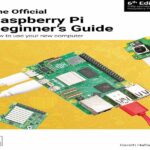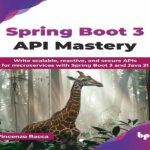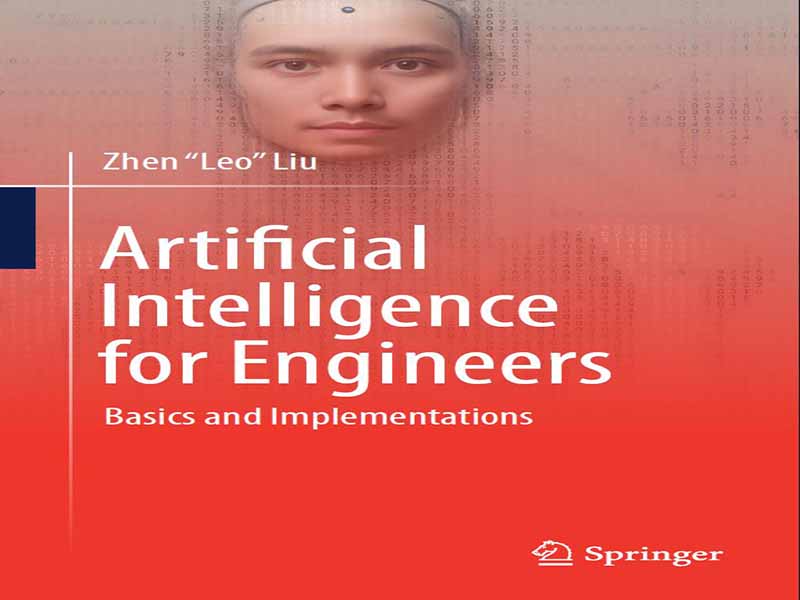- عنوان کتاب: Artificial Intelligence for Engineers – Basics and Implementations
- نویسنده: Zhen “Leo” Liu
- حوزه: مبانی هوش مصنوعی
- سال انتشار: 2025
- تعداد صفحه: 441
- زبان اصلی: انگلیسی
- نوع فایل: pdf
- حجم فایل: 4.38 مگابایت
این کتاب دانش اولیه و مجموعه ابزارهای ضروری مورد نیاز افرادی را که می خواهند وارد هوش مصنوعی (AI) شوند، ارائه می دهد. این کتاب به ویژه برای آن دسته از دانشجویان کالج، دانشجویان فارغ التحصیل، مربیان و علاقمندان فناوری اطلاعات که دارای ذهنیت مهندسی هستند مناسب است. به این معنا که ایده انجام سریع و منظم کار با درک کافی از چرایی و چگونگی انجام آن در خدمت است. این برنامه به گونه ای طراحی شده است که به شما امکان می دهد در کوتاه ترین زمان تصاویر بزرگی را برای موضوعات هوش مصنوعی و موضوعات ضروری AI بدست آورید. بر اساس تصویر(ها)، مقادیر مناسبی از دانش نظری زمینه سازی می شود تا به یادگیرنده کمک کند تا اطلاعاتی در مورد اساسی ترین مفاهیم و الگوریتم ها به دست آورد. این الگوریتمها به گونهای معرفی و فرمولبندی شدهاند که زبانآموز میتواند به راحتی آنها را برای کاربردهای واقعی با تلاش کمی پیادهسازی کند. خلاصه می خوانی، می فهمی، امتحانش می کنی و می تونی حلش کنی. این کتاب توسط زبان آموز برای زبان آموزان تهیه شده است. به دلیل گستره وسیع و توسعه سریع هوش مصنوعی، مواد آموزشی موجود مانند کتاب های درسی متنوع هستند. اصطلاحات متناقض، تمرکز متمایز افراد از حوزه های کاربردی مختلف، اطلاعات نادرست/گمراه کننده از اینترنت، و تکامل سریع ابزارهای موجود وجود دارد. در نتیجه، مشکل اصلی یادگیرندگان کمبود اطلاعات نیست، بلکه برعکس آن است: اطلاعات بیش از حد وجود دارد. یک ناامیدی رایج، شکافها و درگیریهای متعددی است که وقتی میخواهیم چنین دانشی را سازماندهی کنیم تا یک سواد سازگار و کارآمد را شکل دهیم، به راحتی میتوانیم با آنها مواجه شویم. ممکن است لازم باشد چندین کتاب بخوانیم، چندین دوره واقعی یا آنلاین بگذرانیم، وبلاگ ها یا آموزش های زیادی را مرور کنیم، و چندین ابزار را از طریق راهنمای کاربر/راهنمای آنها یاد بگیریم تا در نهایت به آنچه می خواهیم برسیم. در نهایت، متأسفانه ممکن است متوجه شویم که بسیاری از تلاشها غیرضروری است، در حالی که زمان زیادی برای رسیدگی به ناهماهنگیها، شکافها و سردرگمیهای ناشی از فرآیند فوق صرف میشود. این کتاب توسط زبان آموزی که از تمام مسائل فوق رنج برده است برای سایر زبان آموزانی که می خواهند از چنین مسائلی اجتناب کنند تهیه شده است. این کتاب، اگرچه با عنوان هوش مصنوعی، بیشتر به هوش مصنوعی اعدادی اختصاص داده شده است که توسط الگوریتمهای یادگیری ماشین نشان داده میشود، که غالباً موج سوم / جزر و مد AI نامیده میشود. رایج ترین و کاربردی ترین موضوعات یادگیری ماشینی انتخاب و معرفی می شوند. این شامل مقدمه هایی برای موضوعاتی است که برای به دست آوردن یک درک اساسی از یادگیری ماشین لازم است، مانند مدل های خطی، درخت تصمیم، الگوریتم های بیزی، و الگوریتم های خوشه بندی، و همچنین موضوعات پیشرفته تر مانند یادگیری عمیق و یادگیری تقویتی. این تلاش میکند تا اصطلاحات اساسی، الگوریتمهای اساسی/متداول و ابزارهای مفیدی را که ممکن است در یک سفر معمولی برای یادگیری و اجرای هوش مصنوعی معاصر با آنها مواجه شود، پوشش دهد. هدف این کتاب ایجاد تعادل بین عملگرا بودن و نظری بودن است. بسیاری از یادگیرندگان هوش مصنوعی، به ویژه آنهایی که در برنامه های مهندسی هستند، تمایل دارند تا یک مشکل را در اسرع وقت حل کنند، به عنوان مثال، با استفاده از برخی کدهای هوش مصنوعی یا کتابخانه های اینترنت. این معمولاً با توجه به بلوغ بسیاری از ابزارهای هوش مصنوعی به خوبی کار می کند. با این حال، ممکن است منجر به استفاده غیر ضروری و نامناسب از چنین ابزارهایی شود و مانع یادگیری بیشتر موضوعات شود. برعکس، برخی دیگر از فراگیران سعی میکنند با ریاضیات پیچیده و دانش کامپیوتری سطح پایین شروع کنند، که میتواند به راحتی آنها را دلسرد کند و در نهایت در بسیاری از موارد نیازی به آنها نباشد. هر یک از موضوعات (یا فصلها) در این کتاب خط داستانی خاص خود را اتخاذ میکند، که ممکن است وجه اشتراکی با موضوعات دیگر داشته باشد، در حالی که همچنان منحصربهفردی است که از توسعه تاریخی و ماهیت الگوریتمی خود ناشی میشود. این کتاب برای دوره های معمولی در مقطع کارشناسی، کارشناسی ارشد، یا دوره های فهرست بندی شده دوگانه با تقویم مبتنی بر ترم طراحی شده است. بر این اساس، 16 فصل آن 16 موضوع ضروری را برای هفته های 15 تا 16 در یک ترم معمولی دانشگاه ارائه می کند. این کتاب در یک دوره لیست دوگانه شامل دانشجویان کارشناسی و کارشناسی ارشد مهندسی تست شده است، که در آن هر هفته یک سخنرانی و یک آزمایشگاه کامپیوتر برای هر موضوع وجود دارد. بنابراین، مواد آموزشی و یادگیری اضافی، از جمله فیلم های سخنرانی، یادداشت ها، و کد، در دسترس هستند. ثابت شده است که کتاب و مطالب مرتبط با آن می توانند به دانش آموزی با دانش محدود یا حتی بدون دانش در زمینه کدنویسی، تجزیه و تحلیل داده ها و یادگیری ماشین کمک کنند تا یک توانایی اساسی و رقابتی برای درک، برقراری ارتباط و پیاده سازی هوش مصنوعی ایجاد کنند. به همین دلیل، این کتاب می تواند مورد توجه زبان آموزانی باشد که متخصص یا رشته ای در علوم کامپیوتر نیستند اما می خواهند 15 تا 16 هفته یا 45 ساعت تجمعی (1.5 ساعت در هر جلسه × 2 جلسه در هفته × 15 هفته) برای یادگیری هوش مصنوعی وقت بگذارند. این کتاب همچنین میتواند به عنوان یک کتاب مرجع برای متخصصان هوش مصنوعی پیشرفتهتر که میخواهند الگوریتمهای اساسی را برای بررسی الگوریتمهای آموختهشده یا یادگیری موضوعات جدید ناآشنا بررسی کنند، استفاده شود. این کتاب با فصلی برای مبانی هوش مصنوعی شروع می شود که هر دو تصویر بزرگ هوش مصنوعی را با بحث در مورد اینکه چرا باید هوش مصنوعی را بررسی کرد…
This book presents basic knowledge and essential toolsets needed for people who want to step into artificial intelligence (AI). The book is especially suitable for those college students, graduate students, instructors, and IT hobbyists who have an engineering mindset. That is, it serves the idea of getting the job done quickly and neatly with an adequate understanding of why and how. It is designed to allow one to obtain big pictures for both AI and essential AI topics within the shortest amount of time. Based on the picture(s), suitable amounts of theoretical knowledge are contextualized to help the learner gain information about the most essential concepts and algorithms. These algorithms are introduced and formulated in a way that the learner can easily implement them for real-world applications with a small amount of effort. In short, you read it, you understand it, you try it, and you can solve it. The book is prepared by a learner for learners. Available learning materials like textbooks are diverse due to the broad scope and fast development of AI. There are inconsistent terminologies, distinct focuses of people from different application areas, inaccurate/misleading information from the Internet, and fast evolvement of available tools. As a result, a major problem of learners is not the lack of information but the opposite: there is too much information. A common frustration is the numerous gaps and conflicts that we can easily run into when we try to organize such knowledge to form a consistent and efficient literacy. We may need to read multiple books, take several actual or online courses, go through a lot of blogs or tutorials, and learn several tools via their user guides/manuals before we finally get what we want. Eventually, we may sadly find that much of the effort is unnecessary, while a lot of time is used to address the inconsistencies, gaps, and confusion arising during the above process. This book is prepared by a learner who has suffered from all the above issues for other learners who want to avoid such issues. This book, though titled Artificial Intelligence, is mostly devoted to numeric AI represented by machine learning algorithms, which predominate the so-called third wave/tide of AI. The most common and useful machine learning topics are selected and introduced. This includes introductions to topics that are needed to gain a basic understanding of machine learning, such as linear models, decision trees, Bayesian algorithms, and clustering algorithms, as well asmore advanced topics like deep learning and reinforcement learning. It attempts to cover the essential terms, basic/common algorithms, and useful tools that one may encounter in a typical journey for learning and performing contemporary AI. The book aims to strike a balance between being pragmatic and theoretical.Many AI learners, especially those in engineering applications, tend to solve a problem as quickly as possible, for example, using some AI code or libraries from the Internet. This usually works well considering the maturity of many AI tools. However, it may lead to unnecessary, inappropriate use of such tools and hinder further learning of the topics. On the contrary, some other learners try to start with intricate math and bottom-level computer science knowledge, which can easily discourage them and eventually turn out to be not needed in many cases. Each of the topics (or chapters) in this book adopts its own storyline, which may share a commonality with other topics while still maintaining uniqueness that stems from its own historical development and algorithmic nature. The book is designed for a typical undergraduate, graduate, or dual-listed course with a semester-based calendar. Accordingly, its 16 chapters present 16 essential topics for the 15 to 16 weeks in a typical university semester. The book has been tested in a dual-listed course containing both undergraduate and graduate students from engineering, in which each week had one lecture and one computer lab for each topic. Thus, additional teaching and learning materials, including lecture videos, notes, and code, are available. The book and associated materials have been proven to be able to assist a student with limited or even no knowledge in coding, data analytics, and machine learning to develop a basic and competing ability to understand, communicate, and implement AI. Due to the same reason, the book can also be considered by learners who are not an expert on or major in computer science but want to take 15 to 16 weeks or 45 cumulative hours (1.5 hours per session × 2 sessions per week × 15 weeks) to learn AI. This book can also be used as a reference book for more advanced AI practitioners who want to check the basic algorithms for reviewing a learned algorithm or learning new unfamiliar topics. This book starts with a chapter for the basics of AI, which both outlines a big AI picture by discussing why to look into AI, what is AI, the history of AI, AI vs. traditional engineering methods, as well as AI applications in engineering and other sectors, and presents the AI basics including the basic concepts, common algorithms, and challenges and issues. Next, in Chap. 2, common tools needed for implementing AI, including coding language and environment, data manipulation and visualization tools, machine learning and data analysis libraries, and deep learning packages, will be introduced. Following that, typical supervised learning topics, including linear models, decision trees, support vector machines, Bayesian algorithms, neural networks, and deep learning, will be presented in Chaps. 3–7. Ensemble learning will also be introduced in Chap. 9 based on them. After that, four typical unsupervised learning topics, i.e., clustering, dimensionality reduction, anomaly detection, and association rule learning, will be explored in Chaps. 10– 13. Reinforcement learning will be introduced using two chapters: Chap. 14 for the basics of reinforcement learning and value-based reinforcement learning, and Chap. 15 for policy-based reinforcement learning. Finally, Appendix A delivers appendices for more detailed information on AI’s foundational and ancillary knowledge in math, optimization (solvers), and evaluation metrics.
این کتاب را میتوانید از لینک زیر بصورت رایگان دانلود کنید:
Download: Artificial Intelligence for Engineers




































نظرات کاربران